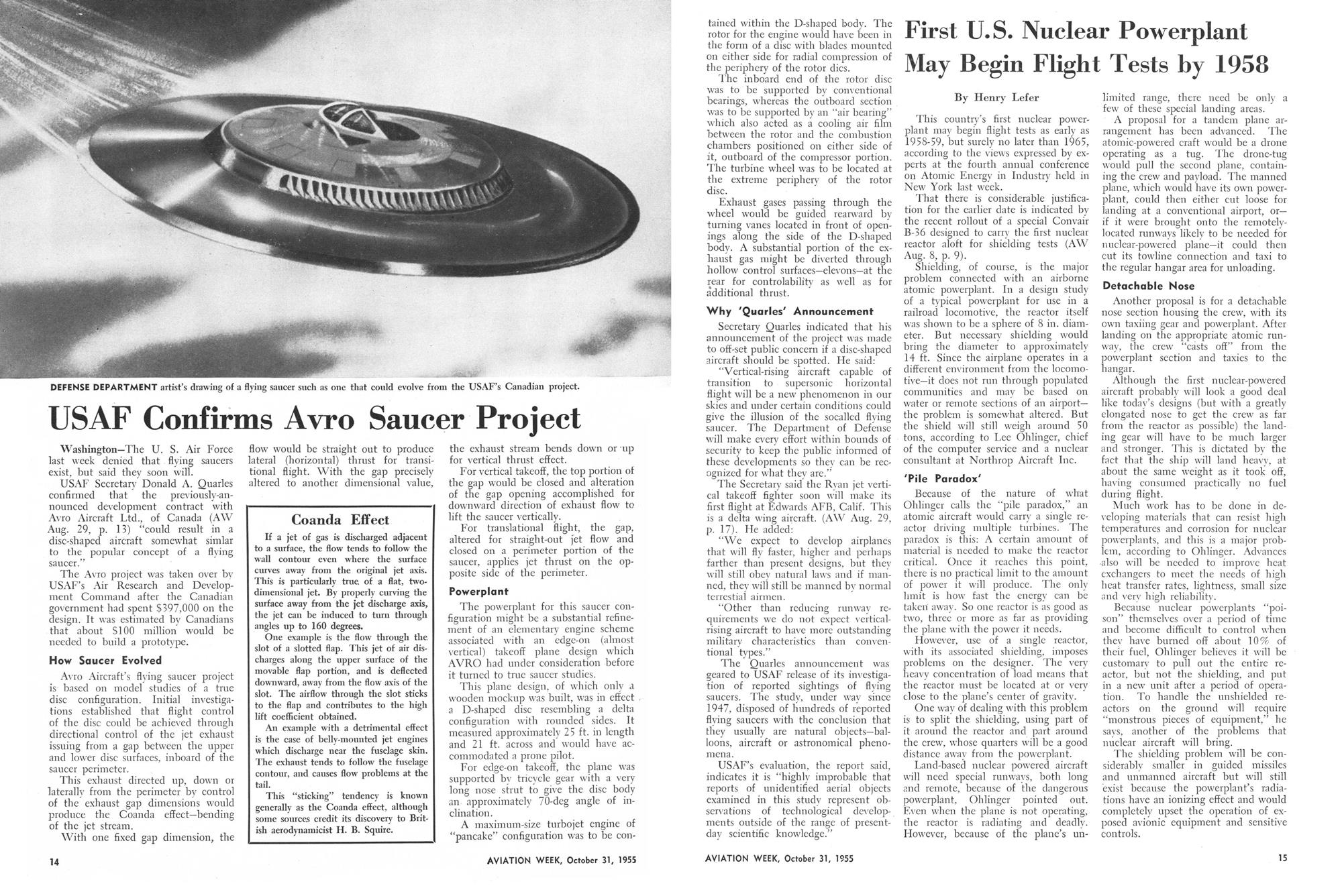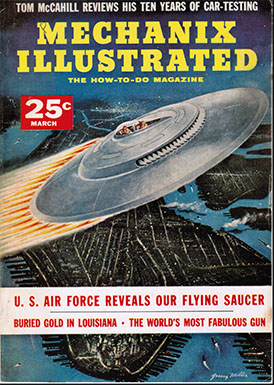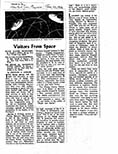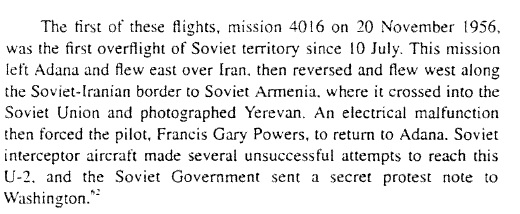Aftermath
Naturally, despite the precautions, Russell's sighting was too hot to be kept completely quiet. Tom Towers, the aviation columnist for the Los Angeles Examiner, soon heard the story through the grapevine and attempted to contact the Senator for confirmation. His first letter went unanswered, but a followup got an evasive response from Russell:
Permit me to acknowledge your letters relative to reports that have come to you regarding aerial objects seen in Europe last year. I received your letter but I have discussed this matter with the affected agencies of the government and they are of the opinion that it is not wise to publicize this matter at this time. I regret very much that I am unable to be of assistance to you.
A few months later, Max B. Miller, a civilian ufologist from the Los Angeles-based group "Flying Saucers International" wrote to Russell about rumors he had heard concerning the incident. Al Chop, the former Blue Book public relations official, had told Miller's group that Russell had seen four flying saucers take off at tremendous speed during his European trip. Miller reported that Chop felt that the secrecy surrounding the incident was another example of official censorship designed to keep the public in the dark about UFOs. Would Russell be willing to make a formal report to Flying Saucers International, Miller wondered? Of course, anything he said would remain strictly confidential. No doubt Allen Dulles would have been furious that well-connected UFO insiders like Chop were leaking (and exaggerating) material that would remain classified Top Secret for the next three decades; the letter is classic evidence of why UFOs were still treated as a serious security issue. There is no indication that Russell ever replied.
Like Gros and Russell, Hathaway and Efron were apparently enjoined to secrecy about the Baku event. It was even omitted from Efron's classified diary, and the Senator's only newsworthy comment to reporters who greeted him on his return from the USSR was that he had been surprised to learn that Soviet doctors encouraged their patients to exercise vigorously after heart attacks. (Interestingly, Desmond Earl insists that the Avro team was not informed of the sighting.)
How did the incident affect Russell personally? The security-conscious Senator left virtually no reference to it in his papers, and his private beliefs concerning flying saucers are unknown. There is no question that Russell came back from his trip with increased concerns over the Soviet military air threat. He launched Symington's airpower subcommittee within a few months of his return.
The Senator also was definitely impressed by the encounter with General "Egorov," the long-range pilot, whom he evidently believed to have been the genuine article. When the Soviets launched the first earth satellite in 1957, Russell's very first speech linked Gromov's 1937 flight to the US to Soviet missile technology:
"The principle significance of this announcement is not solely in the fact that the Russians have launched the first satellite," he told the audience at the Gordon County, Georgia "Industry Appreciation Day" celebration on October 5, 1957,
From the point of view of the Free World, the greatest threat lies in the fact that [the satellite launch] confirms the Russian claim that she has perfected an inter-continental ballistic missile.... As I have said time and again, we have consistently under-estimated the productive capacity of the Russians. Before the Committee on Armed Services, I have reminded the officials of the Executive Branch of the Government time and again of the fact that the Russians built and successfully flew aircraft over the North Pole and into this country back in the early 1930's.
In 1958, when a report surfaced in Aviation Week that the Soviets had begun test flights of a nuclear-powered bomber, Russell repeated the north pole statement verbatim in a speech on the necessity of boosting funding for the Aircraft Nuclear Propulsion project.
Russell was too close to the CIA to openly discuss the sighting against the Agency's wishes, but nevertheless, there were a few minor leaks that seem to have originated with him. A garbled version of the Baku story made its way into the airpower subcommittee's 1956 chronology, and there are hints that at least some of the Senator's friends heard the story behind closed doors.
On October 17, 1957, for example, a Russell constituent, one C. Roger Carter of Ft. Valley, Georgia, wrote to Dr. Charles Stark Draper, the MIT missile guidance expert, to congratulate him on his achievements and offer his amateur opinions on future gyroscope projects:
Dear Dr. Draper: I have just read the article in "The Reader's Digest" about your guiding mechanism for airplanes.... Thank God you have perfected the gyroscopic mechanism that will guide planes in the atmosphere as well as in space....The principle of the gyroscope completes the Technological requirements for building the flying saucer, launching an air base in space, [and] building an armored sphere that will fly and which would replace tanks on the ground...
Carter sent a copy of the letter to Senator Russell. In view of the appearance of the "flying platform" item in the 1956 Symington subcommittee chronology and the Carter letter on gyroscopic saucers, it seems likely that Russell suspected that the objects he saw were in fact some type of Soviet secret weapon.
Ufology Reacts
The sudden release of Project Blue Book Special Report 14 took civilian UFO investigators by surprise. Max Miller queried Ed Ruppelt about Quarles' seemingly unprovoked saucer press conference. Ruppelt was mystified by Quarles' statement and the timing of the release. The former head of America's inquiry into UFOs told Miller that he "could not understand why the Air Force had held on to the report for two years and released a 1953 study in 1955 as the 'latest hot dope.'"
The reaction of civilian UFO researchers to Special Report 14 was generally negative. The Lorenzens, for example, would later deride the Air Force for spending $100,000 of the taxpayer's money on the multi-month Battelle study which "reversed" the conclusions of the three-day Robertson committee. APRO's Venezuelan representative wrote a sarcastic letter to Time magazine expressing "relief" at Quarles' revelations concerning American saucer projects:
If, then, we here happen to see again any small, strange, humanoid, hairy bipeds emerging from grounded saucers to frighten the citizenry, examine railway lines, pull boulders and dirt off the highways and load it aboard their strange craft, we will know that they are only United States Air Force pilots sent by Quarles to collect samples of Venezuelan dirt and rocks, and in the event of any complications arising we will know where to direct complaints.
Donald Keyhoe took Special Report 14 almost as a personal affront. The report was incomprehensible to the veteran saucer writer; it contained nothing about the teeth-gritting night saucer intercepts by Air Defense Command pilots, its statistics were bogus, the attempted reconstruction of a "typical unknown" was futile. To Keyhoe, it seemed that the Air Force had gone to almost unbelievable lengths to invent the irrelevant data included in the report. None of the important cases, his cases, the ones that he believed proved the nuts-and-bolts reality of extraterrestrial spaceships, were included. If this was the Air Force's definitive word on UFOs, it proved the existence of a grand conspiracy and coverup at the highest levels. He lashed out in the press on October 27, calling the Quarles statement an "insult" and a "deliberate attempt to conceal facts from the public," and daring the Air Force to deny that it still scrambled fighters on unknown radar targets.
 |
Aviation Week article on Special Report 14 and the Avro Saucer (October 31, 1955) Click to enlarge article. |
In the days and weeks following the Quarles press conference, a flurry of stories on saucer-like vertical takeoff aircraft appeared in major US newspapers and magazines. On November 4, U.S. News and World Report triumphantly shouted "Flying Saucers: You'll See Some Official Ones Soon" in a long article on the Quarles statement illustrated with the DOD drawing of the Avro saucer. The magazine finally felt vindicated over its 1950 story on the alleged Navy saucer project:
In the issue of U.S. News and World Report for April 7, 1950 -- five years ago -- there was a description of the 'flying saucer" projects of that time. Projects referred to then also were "convertiplanes," combinations of helicopters and conventional aircraft. Pictures of those models show a close similarity to the planned Air Force convertiplanes of 1955.... Man-made "saucers," now to be built, will have the same basic characteristics that, since 1947, have astounded thousands of persons who reported seeing "flying saucers." The new craft will be able to rise vertically, or almost vertically, travel horizontally at speeds far above normal airplane speeds, maneuver more rapidly than conventional planes, perform feats of turning and climbing that would be impossible with conventional aircraft. Over a five-year period, "flying saucer" reports came in from all sections of the country, but the biggest concentrations of reports were from New Mexico, Southern California, East Texas and Ohio. Development of new types of convertiplanes, at the same time, has been going on principally in Southern California,Texas and Ohio, with some research at missile ranges in New Mexico -- the same areas where most "saucers" were reported during this five-year period. Actual aircraft appearing in "saucer" reports in the U.S. thus far have been American varieties, not foreign vehicles bent on espionage.... Behind the whole array of strange objects now being developed is the problem of runways.... Experimentation... has been going on constantly since early in World War II. It has produced a wide variety of convertiplane types, some circular, some resembling helicopters, some still on the "secret" list.
The article went on to mention a few US VTOL aircraft then in development, hinting that they, too, might be perceived as saucers. It concluded with a remarkable observation:
Developments like these all have taken place in the years since World War II, in the same period in which "flying saucers" caught the popular imagination. The New York Herald Tribune, noting this, asked editorially one day last week: 'Assuming there have been no such things as saucers, how did it happen that men and women began thinking they saw them just when they were about to come within the purview of practical engineering?'
On December 15, the security level of Project 1794 was temporarily downgraded to "unclassified" to permit limited revelations concerning the technology of the vehicles. This did not, however, mean that the project had "gone white." Four days later, Air Materiel Command Headquarters at Wright Field requested the US Customs Department to clear classified MX-1794 models destined for the MIT wind tunnels into Boston on the 27th "without, repeat, without inspection."
A day or two after New Years', Alexander Lippisch called reporters to Collins Aircraft in Cedar Rapids to give a hastily-organized but well-choreographed demonstration of a flying model of his cigar-shaped VTOL Aerodyne Mk II. Time and Life both ran articles on the display in their January 9 issues. Both magazines identified Lippisch as the inventor of the delta wing and the designer of the Me 163. In the same issue, Time also carried an article on the Hiller VZ-1 Pawnee and the De Lackner Aerocycle, a pair of Army prototypes of one-man, propeller-driven VTOL flying platforms based on Charles Zimmerman's designs. On January 10, Edmond R. Doak was granted a patent on his concept for a VTOL flying disc. Doak had applied for the patent on July 1, 1950; the application had remained in limbo for over five years.
On February 12, The New York Times published an article titled "New Ways of Flying: Summary of Contemporary Studies Concerned With Wingless Aircraft," which referred to the Quarles press conference, the Avro saucer, the Hiller Flying Platforms, a French saucer designed by Rene Couzinet, and the Lippisch Aerodynes. Two days later, the US Patent Office granted Lippisch a patent on the Aerodyne. He had filed the application over three years before. One of the biggest leaks came in the March issue of Mechanix Illustrated, which reached newsstands near the end of February. The magazine's cover story was captioned "U.S. Air Force Reveals Our Flying Saucer," and showed an artist's conception of a two-man MX-1794 streaking into the night sky over lower Manhattan.
 |
"Ever since 1950 when TRUE The Man's Magazine discussed the existence of flying saucers, the world press has been continuously interested in the possibilities of disc-shaped aircraft," the editors noted in a passing nod to Keyhoe's seminal story (True and Mechanix Illustrated were both published by Fawcett Publications Inc.). "If you haven't seen saucers yet, you will -- and they'll be built to Air Force specifications." The feature article was written by none other than the veteran German rocketry promoter Willy Ley.
Even the most devoted science news and science fiction readers were surprised by a series of official releases that enlivened newspaper reading last summer and fall [Ley wrote]. First there was the White House release about artificial satellites, to become a reality no later than 1957. Then came the Department of Defense "flying saucer" release, dealing not with machines from outer space manned by small green men, but with a product of terrestrial slide rules and American factories, to be flown by American pilots.... Secretary of Defense Donald Quarles was quoted as saying that AVRO Ltd. of Canada had a USAF contract to build an aircraft similar to the popular flying saucer concept. In subsequent news articles journalists observed sagely that something called the Coanda effect, a new principle in aerodynamics, had made the disc-like aircraft possible.
By the spring of 1956, many Americans probably believed that the era of real terrestrial flying saucers did lie in the near future. Significant leakage of the Russell UFO story had been headed off and Blue Book Special Report 14, which had been released on the Air Force's terms, could be used to undermine the credibility of saucer enthusiasts. While the "perception management" effort (and there clearly had been one) probably had a minimal influence on the Soviet response to the Gopher-Genetrix reconnaissance balloon overflights, if that had been one intention, the Air Force had reason to hope that future domestic UFO reports would be perceived in the context of saucer-like American secret weapons. The 1952 Blue Book fiasco had been partially redeemed.
Captain Charles Hardin, Project Blue Book's head, wrote to General Harold Watson in February 1956 on his satisfaction over the handling of the release of Special Report 14 and its aftermath.
A review of recent books on Unidentified Flying Objects appearing in the New York Times issue of 22 January 1956 is highly complementary to our Special Report 14. Written by Jonathan N. Leonard, a science editor and author of Flight into Space, it gives considerable credence and support to our UFO position. It would appear from this review that the downgrading [i.e., declassification] and subsequent release of Special Report 14 is serving well the purpose for which it was intended.
 |
(click to enlarge) |
Epilogue
On July 4, 1956, the CIA's U-2 spyplane made its first penetration of Soviet airspace. Pilot Hervey Stockman took off from Wiesbaden, Germany, flew east over Poland and Belarus, then turned north, heading for Leningrad. After this a pass was made over the Baltic states before returning to Wiesbaden after nearly nine hours in the air. The next day another mission overflew Moscow.
US Intelligence was interested in obtaining imagery of targets on the USSR's strategic southwestern flank as well, and a new U-2 flight operations base was established at Incirlik, Turkey, to support these missions. Several peripherial missions were conducted before an actual penetration was attempted. On November 20, mission 4016 lifted off from Incirlik to conduct the seventh U-2 flight into Soviet territory. The aircraft climbed to over 60,000 feet, flew east into Iran, then turned north toward the USSR. When he reached Soviet airspace, the U-2's pilot activated its giant "B-camera." Its lens scanned back and forth, photographing the terrain miles below in overlapping swaths extending from horizon to horizon. The aircraft flew straight up the Caspian coastline, turned northeast just west of the railroad junction where Russell and his companions had sighted the saucers, then passed over Baku itself. The U-2 experienced mechanical problems later in the flight, and its young pilot, Francis Gary Powers, would be forced to return to base earlier than planned. It was his first overflight of the Soviet Union. He would be shot down by an SA-2 surface-to-air missile near Sverdlovsk on May 1, 1960.
 |
(click for more detail, see pdf page 32) |
Map below left shows enlargement of Powers' flightpath over the Baku peninsula. Detailed map is on right for comparison. Interestingly, the Russell sighting location, indicated, is essentially at one of his turnpoints. Coincidence?
